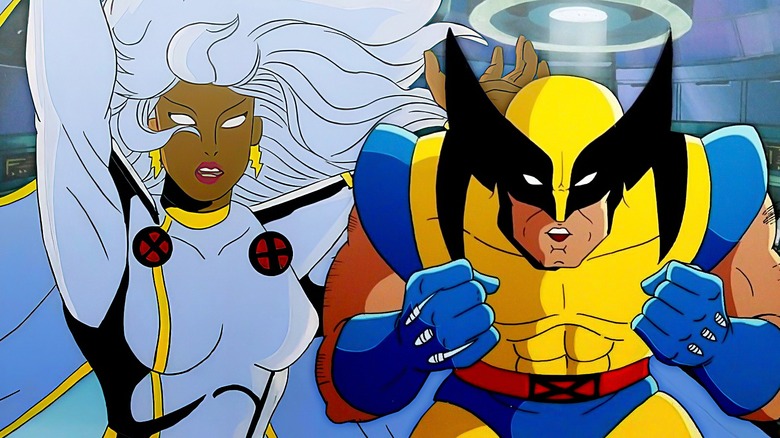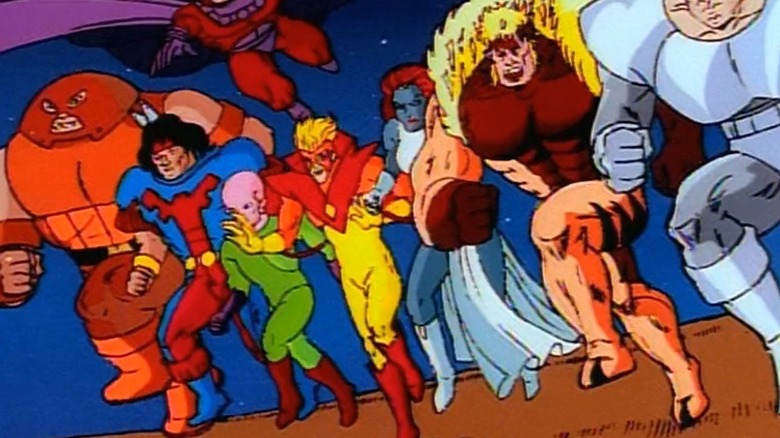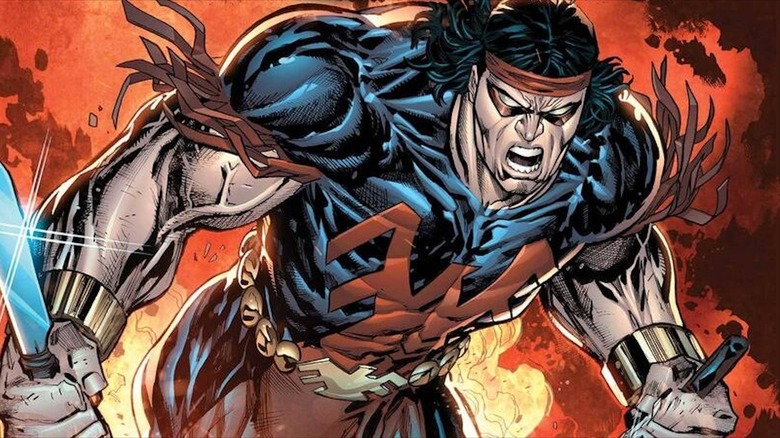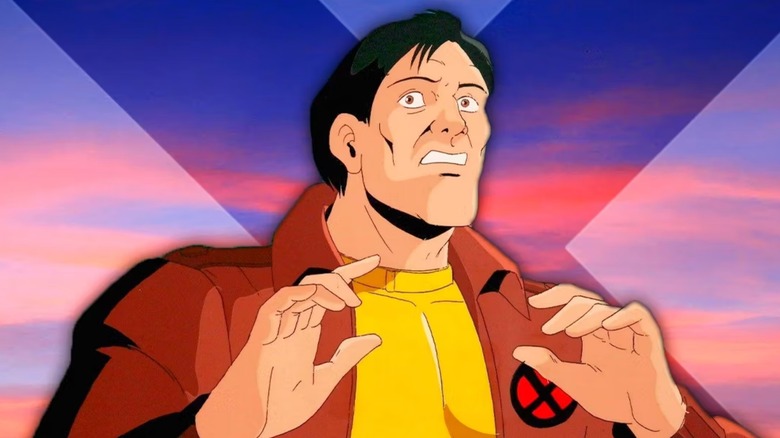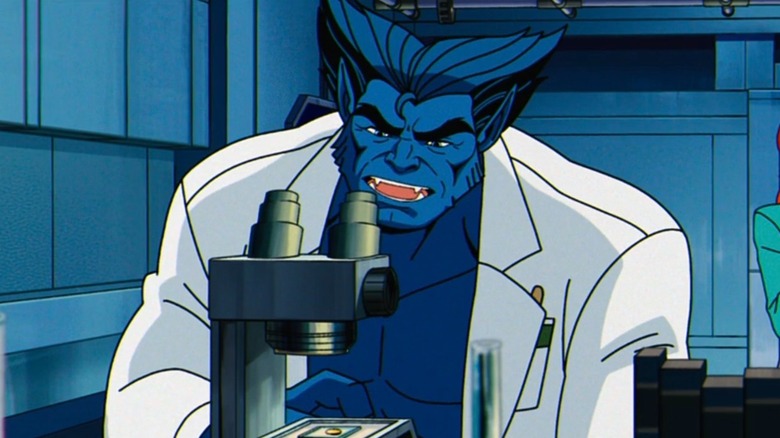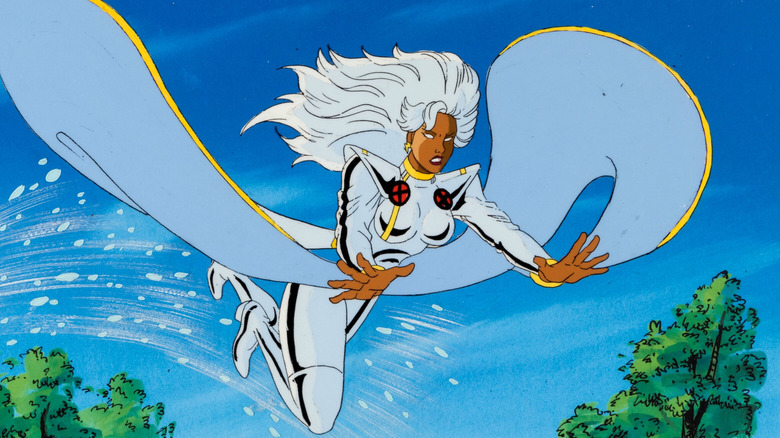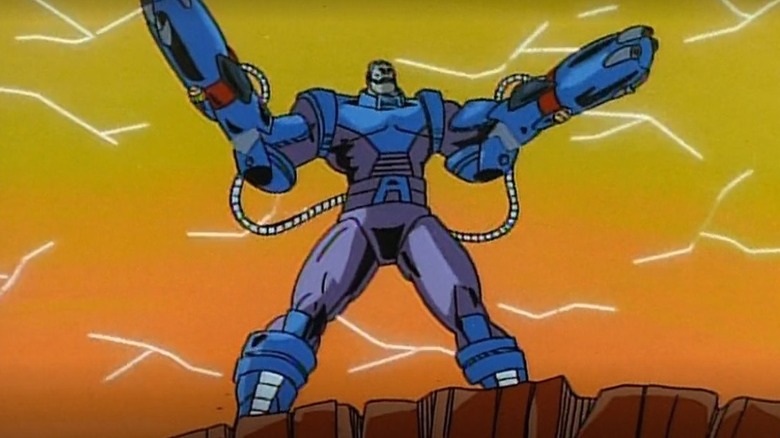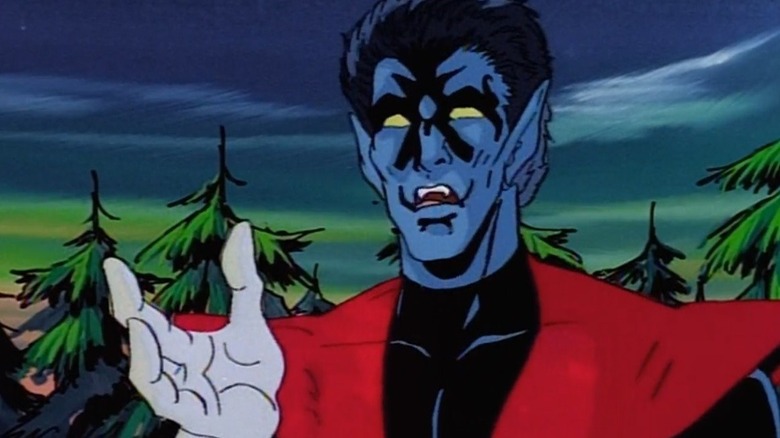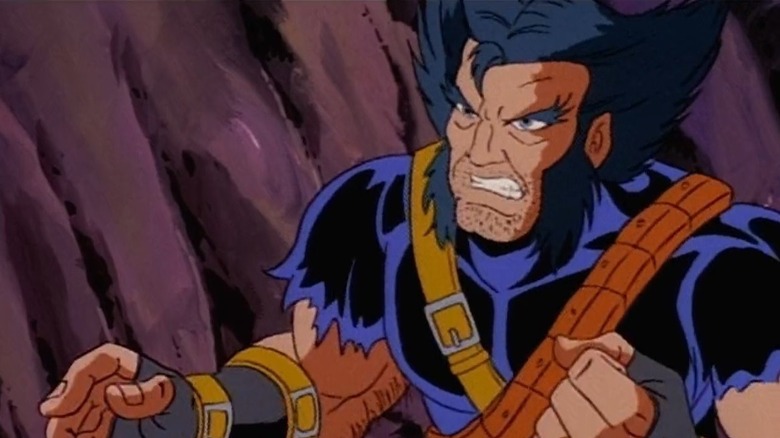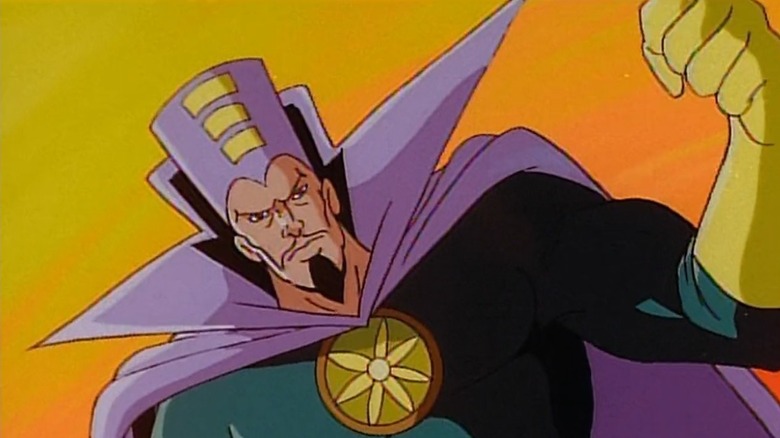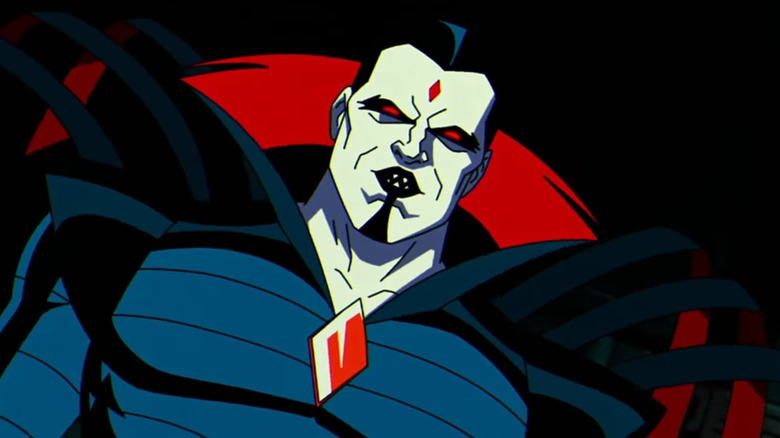We Rewatched X-Men: The Animated Series And It's Completely Different Now
"X-Men: The Animated Series" stands the test of time. It's more than a cartoon; it's the quintessential version of Marvel's favorite mutants. The 1992-1997 show introduces viewers to Professor Charles Xavier and his superpowered team known as the X-Men as they do battle with a glut of enemies, including Magneto, Mister Sinister, Apocalypse, and mutant-hating humans. The series also borrows — freely and heavily — from the comic books, adapting seminal storylines such as "Days of Future Past" and "The Phoenix Saga."
In many ways, "X-Men: The Animated Series" paved the way for the MCU by featuring a host of characters from across the Marvel Universe and connecting them to the overarching narrative. From Deadpool to Captain America and the Howling Commandos, there's no shortage of heroes — or villains — popping up across the episodes and adding another layer to the story, while also teasing the infinite possibilities. The greatest testament to the show's legacy, though, remains how the fans refused to let it die. For nearly 30 years, they rallied for a continuation of the program. Eventually, it arrived in the form of "X-Men '97," the Disney+ revival series that picks up after the events of Season 5.
With all that said, and in celebration of the X factor of this special superhero show, let's look back at "X-Men: The Animated Series" and examine the biggest takeaways after a rewatch.
The green villain in the intro sequence isn't an actual X-Men character
Mention "X-Men: The Animated Series" to any fan and they will start whistling the iconic theme song in a heartbeat. The opening credits sequence remains on another level of awesomeness and more than sells the show to any potential viewer who might have been undecided beforehand. For longtime "X-Men" fans, it's always fun to identify all the characters appearing in the montage. However, there's one villain's identity that's always puzzled the viewers.
As the Brotherhood of Mutants rush toward the X-Men, it's easy to point out Juggernaut, Thunderbird, Magneto, Pyro, Mystique, Sabretooth, and Avalanche — but who is the smaller guy with a big pink head who's dressed in green? Could he be the Leader? Maybe the Gargoyle? Or a really badly drawn version of DC villain Sinestro?
The answer is: He's nobody. In the book "Previously on X-Men: The Making of an Animated Series" (via CBR), showrunner Eric Lewald revealed that the credits' designer, Larry Houston, told him the character was nothing more than an art error. "[Larry] recently told me (after a fan asked) that the bald guy was a mistake by AKOM (the animation studio) that they wouldn't fix," Lewald wrote. "He isn't anybody! Who he may have been meant to be has long been forgotten. He's just another example of a flaw caused by lack of time and money, but one that seems to have been forgiven by the fans."
Morph takes Thunderbird's place in X-Men: The Animated Series
The two-part "Night of the Sentinels" opener kickstarts Season 1 of "X-Men: The Animated Series." Not only does it introduce Jubilee as the team's newest member, but it also seemingly kills off Morph as he pushes his bestie, Wolverine, out of the way and gets roasted by a Sentinel's blast. It's a surprising but impactful moment that has widespread consequences for the rest of the season and thereafter.
It isn't the first time the "X-Men" franchise sacrificed a new-ish character in a dramatic fashion either. Thunderbird meets his tragic demise in "Uncanny X-Men" #95 — by Chris Claremont, Len Wein, and Dave Cockrum — which sees Professor Xavier reacting with the same shocked face as he does when Morph dies on the show. Thunderbird does show up in "X-Men: The Animated Series" — most notably in the opening credits — but it's never made clear which version of the character it is.
For die-hard fans, though, the question remains: Was Thunderbird ever meant to be the mutant who dies in "Night of the Sentinels"? Sharing a summary of the story's original plan, Eric Lewald confirmed in "Previously on X-Men: The Making of an Animated Series" that Thunderbird was meant to be a part of the X-Men team and would have died like Morph. However, the creative team decided it would be in poor taste to kill off the only Native American character on the show and went with Morph instead.
Morph isn't meant to survive
Speaking of Morph, "Night of the Sentinels" makes him deader than Zack Snyder's vision for the DC Extended Universe. Morph's gone, and Wolverine feels the heart-wrenching loss of his shape-shifting friend who died on the battlefield to save his furry hide. Later in the series, though, a big bombshell drops: Morph is still alive! The devious and aptly named Mister Sinister saved Morph after the Sentinel blast and uses him as his pawn against the X-Men.
But was the plan always for Morph to return in Season 2? According to Eric Lewald, he was supposed to be a one-and-done deal. The showrunner revealed to Blast from the Past how Morph was going to be nothing more than cannon fodder and only used to advance the story. He was based on the Marvel character known as the Changeling; however, the name was changed to Morph to avoid any possible lawsuits from DC, since Teen Titans' Beast Boy was also known as Changeling at a certain point in his convoluted comic book history.
"Morph proved so popular," Lewald said, "and it was a month-long struggle to be allowed to have him killed (and I believe [producer] Sidney [Iwanter] may have helped make a deal with Broadcast Standards) that we were, to my complete surprise, asked to bring him back again after the first 13 episodes."
Beast isn't really a main character in Season 1
Another major event that occurs in "Night of the Sentinels" involves the capture and incarceration of Beast. Upon a rewatch of the show, it's clear that Dr. Hank McCoy stays on the periphery of the action for much of the first season — only being released from prison in the season finale, "The Final Decision," in what's arguably one of the best moments from "X-Men: The Animated Series." Beast becomes a regular from Season 2 onward.
From a storytelling perspective, it makes sense why Beast is behind bars, but there's another reason (or two) he was chosen for this specific role. As Eric Lewald explained to Blast from the Past, Beast wasn't seen as a primary X-Men character in the first season — despite featuring in the opening credits — so he was essentially the sacrificial lamb here. As they wrote for him, however, the creative team fell in love with his personality and decided to make him a more important character moving forward.
In addition, Lewald believed Beast's endearing personality made him the right character for this specific storyline. "Beast is so articulate that he works beautifully in a court scene," he said. "And he is so reasonable and likable, it's hard for the prosecution to make him out to be a monster. If Wolverine were on the stand, a reasonable judge might think it wise to lock him up." Poor Logan, always catching strays — even from the showrunners.
Three voice actors voiced Storm in the first season
Anyone who watched the original run of Season 1 of "X-Men: The Animated Series" then rewatched it later on would notice that Storm sounds different the second time around. While it's normal for voice actors to depart after one season and be replaced by someone else for new episodes, what was the deal with re-recording all the finished parts already?
The book "Previously on X-Men: The Making of an Animated Series" reveals how three different actors actually played the role of Storm. Eric Lewald disclosed that the original voice actor was white, and the creative team realized it probably wasn't a good idea to have a white woman voice Ororo Munroe, a character of color. Even though it was late into production, they brought in Iona Morris to redo all the lines for Season 1.
However, before Season 2 began, the producers realized they wanted a Canadian actor for Storm — like the majority of the cast — in order to avoid paying residuals for reruns of the show. Since Morris was American, she was out and Canadian Alison Sealy-Smith was in. Sealy-Smith took over for Season 2, and also re-recorded Morris' lines for the reruns of Season 1. The actor would also return to voice Storm in "X-Men '97."
The four-part Beyond Good and Evil plays like the perfect ending, because it was
When it comes to a season finale, the four-part "Beyond Good and Evil" delivers the goods in Season 4. The story sees Apocalypse trying to destroy all of time and space so he can recreate a new world where he reigns supreme. He also tricks Magneto into helping him before the magnetic mutant realizes he was deceived and helps the X-Men in this monumental battle for the fate of the universe. If it sounds similar to the plot of "X-Men: Apocalypse," it's because it is (although a refresher on the entire "X-Men" timeline might be worthwhile since the movies can get messy at the best of times).
"Beyond Good and Evil" possesses all the oomph and finality to be a series finale, as it ties up the story in a little bow and provides closure for heroes and villains. Interestingly, that was the plan from the get-go: as revealed in "X-Men: The Art and Making of The Animated Series," Season 4 was designed to be the end of the show. Many of the animators and people involved in the series had already moved on to other work when news broke that another season had been optioned. Season 5 came in at a reduced budget and without many of the people involved in the previous episodes, hence the show looking and feeling drastically different.
The episode Nightcrawler isn't actually about Christianity
One of the things only adults notice in "X-Men: The Animated Series" is the religious undertone of the Season 4 episode "Nightcrawler." In the story, the mutant Kurt Wagner, aka Nightcrawler, stays in a monastery and his faith in God never falters, regardless of how much the world rejects his devilish appearance. This surprises Wolverine, who confides in Nightcrawler that he lost his faith in religion a long time ago due to everything he's experienced in life. However, the end of the episode sees Logan reading the Bible, leading everyone to believe that he's rediscovered his relationship with God.
Naturally, this event led many fans to presume that Wolverine converts to Christianity. The episode's writer, Len Uhley, disagrees. Uhley explained to Relevant that Wolverine is 95 years old in the series and has experienced a lot in his long life, while also touching upon how the character had practiced Buddhism in the comics at one point. For Uhley, the story is about Logan finding the ability to believe in something and letting go of his resentment toward the world rather than practicing religion.
"At the end of this episode, yes, Wolverine is at the rail, kneeling and reading a Bible passage," Uhley said. "I don't think that he's had a conversion experience but I think that he is exploring. Maybe he's getting in touch with something that he once had in his life, something that gave him comfort at one time."
One arc on the show inspired a popular comics storyline
In "X-Men: The Animated Series" Season 4, the two-part storyline "One Man's Worth" explores an alternate universe where Professor Xavier dies before he's able to form the X-Men. This creates a timeline where mutants and humans are at war, and nothing is as it's supposed to be. Through the use of time travel, a group of heroic mutants is able to change the course of history to ensure Xavier survives and leads his team to a better tomorrow.
While the animated series found itself borrowing from the comic books for its major storylines, "One Man's Worth" did the opposite and inspired the comics instead. Marvel Comics published the memorable "Age of Apocalypse" story arc, which was heavily influenced by the idea of what happens when Xavier dies before he's supposed to. In this version, the evil and power-hungry mutant Apocalypse takes over, so it's up to the X-Men to travel back in time and prevent Xavier from dying.
Eric Lewald admitted to The Beat that he was pleased to see his story adapted for another medium. "'One Man's Worth' was a story I came up with and one of the ones I was most proud of," he said. "But it's also a reminder — most good stories have been told many times in many different forms. Writers of all ages and all times borrow plot points from each other."
A Kang variant shows up in X-Men: The Animated Series
Kang the Conqueror has played a critical role in Phases 4 and 5 of the MCU, as fans have been introduced to several of his different variants. In "Ant-Man and the Wasp: Quantumania," a variant known as Immortus appears in the mid-credits scene. This same character makes a brief cameo in the Season 4 finale of "X-Men: The Animated Series," but his name is never revealed and only eagle-eyed fans and die-hard Marvel fans would know who this is.
In the "Beyond Good and Evil" saga, a sniveling character named Bender tests Bishop's nerves throughout. He doesn't appear to be threatening or malicious, but he's annoying like a gnat. After Bishop and the X-Men defeat Apocalypse, Bender transforms into his true form: Immortus. As one of the keepers of time, Immortus shows his guile by maintaining a close eye on events, only in a different form.
Immortus is never seen again on the show, nor are his motivations ever made clear. However, it's quite the impactful cameo when fans actually realize who he is and his overall importance in the Marvel Universe.
Mister Sinister had a long-term plan
Make no mistake, Mister Sinister establishes himself as one of the unsung characters in "X-Men: The Animated Series." From the shadows, the villain plots and schemes as he plays god with mutants and messes with the gene pool like he's baking a new flavor of cake for teatime. Sinister holds a keen interest in both Cyclops and Jean Grey's DNA, though, as revealed in the Season 2 two-parter "Till Death Do Us Part."
For all intents and purposes, it appears as if both X-Men members escape his clutches and he isn't able to get what he wants out of them. That is, until "X-Men '97" demonstrates how Sinister plays the long game to achieve his goal in the end. In Season 1's "Fire Made Flesh," it's revealed that Sinister replaced the real Jean with a clone (Madelyne Pryor) sometime in the past, with the intention that she and Cyclops reproduce to create a new mutant for him to tinker with. His master plan is to infect baby Nathan with a virus that turns him into the supposed perfect mutant.
It works, since Sinister succeeds in infecting Nathan before the X-Men save the baby. Ultimately, Madelyne and Cyclops make the decision to send the baby into the future to find a cure for him and keep him out of harm's way. With Sinister still at large, though, will Nathan ever be safe? Needless to say, Mister Sinister wins this round.
